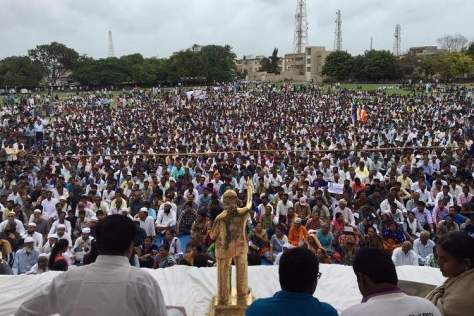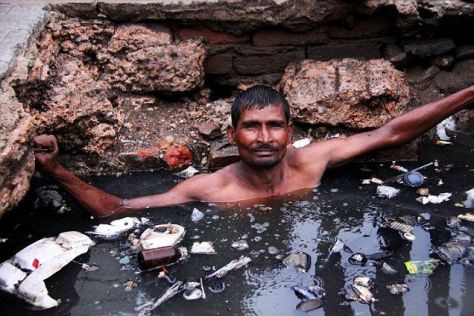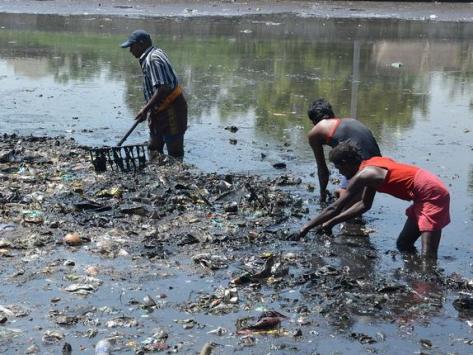
This May Day comes at a very crucial juncture in our history. Crucial, not simply because there is a belligerent Hindu Right government in power but also because it comes in the wake of the most unprecedented belligerence of the upper castes and their all-round violence, especially on the Dalit communities across the land. Last year we had witnessed the most shameful incident of violence in the flogging of four Dalit youth by the cow gangs of Hindutva, which was followed by massive protests by Dalits and joined in by other sections of people, including some of the Left forces, as well. The attack had to do with the very specific form/s of labour that Dalit communities have been made to traditionally perform in Hindu society, in this case, the work of disposing of carcasses of dead animals, skinning them and so on.
We cannot also forget that among the most degrading forms of labour that Dalit communities continue to perform, the most vicious – that of manual scavenging – continues to be performed not in private homes but in government employment, for it is what keeps our cities going.


The labour that Dalit communities are forced to perform is crucially tied to the social position assigned to them in Hindu society. Their subordination and oppression therefore, extends to all aspects of their lives – it is not something that can be neatly separated into a ‘workplace’ and a ‘home’ that is relatively free of the employers’ interference and diktat. The attack and everyday humiliation that a Dalit family has to face, lends this question a specificity, such that call for a serious rethinking of the political responses to them.
Such everyday attacks continue with renewed vigour even as we write. Just the other day a Dalit groom was beaten up in Haryana, over ‘ghurchari’ – because he dared to mount a horse during his wedding. And two days ago we read reports of upper castes pouring kerosene oil into the well from which Dalits drew water. This time their crime was that one of them had dared to hire a band party to welcome the bridegroom at his daughter’s wedding at his village in Madhya Pradesh. No coincidence here that both the states are ruled by the BJP. Interestingly, in this latter case, contaminating the well with kerosene oil was an act of revenge, for the wedding had already been conducted under police protection:
On April 23, Chander Meghwal, a 45-year-old Dalit had welcomed the groom for his daughter Mamta’s wedding with a band party, despite a warning by the dominant upper castes that he would face social boycott if he hired a band party. According to the village tradition the Dalits are only allowed to use ‘dhol’ to welcome the groom. However, Meghwal had informed the administration about the threat and finally the marriage took place under police protection.
Even more significant is the fact that it is not ‘an employer’ that a Dalit has to deal with, on a daily basis, but in fact the majority of the village population, which stands above them in social position. Consequently, dealing with the all round increase in the belligerence of the upper castes is not a simple matter of dealing with a class of employers. Indeed, it might often be the case that those inflicting continuous, daily humiliation on the Dalits are, in other contexts, themselves oppressed. Often, the forms of protest that are seen to be effective in other contexts, turn out to be utterly ineffective in such contexts. Thus, for instance, the widespread anger among Gujarat Dalits after the Una incident led to a mass upsurge and many Dalits took a pledge that they would not remove the carcasses of animals ever in future. However, once the heat of the movement was over and life returned to everyday rhythms, a reverse boycott was reportedly imposed on the Dalits by upper castes.
How then do we fight this menace of caste oppression? Jignesh Mewani, the young charismatic leader who spearheaded the upsurge – and has called once again for countrywide protests on July 11 – correctly realized that this was a battle that had to be fought politically, and that it called for alliances with sympathetic sections of the population.
While sections of the Left joined the protests last year and may do so yet again this year, the challenge really is to rethink the very meaning of labour and labour organizing in today’s India. Do the forms of labour performed by Dalits and Bahujan communities at large, or by poor Muslims for instance to be considered labour – or are they to be consigned to some ‘past’ forms which Leftists have long expected to vanish from the scene with the development of capitalism? Here I am not thinking of the trade unions who are fighting a losing battle in their respective trades, in terms of safeguarding their hard won rights. Those struggles, especially the militant struggles that have lately erupted in the automobile sector, will of course continue. The question here is more of thinking of labour as the axis of a different kind of political mobilization, where the most oppressed communities of labour can become the centre-piece of a new kind of politics. In order to do this we will need to get away from shibboleths like ‘worker-peasant unity’ (which have in any case lost whatever charge they might have once had) and imagine labour itself in a different way as something that cuts across the temporal boundary between the modern capitalist sector and a supposedly backward or traditional precapitalist sector.
Thinking of labour in this way will also mean thinking of ‘class’ not in any essentialist sense (with concomitant notions of ‘class consciousness’ and so on) but of applying ourselves to the actual concrete situation on the ground where labour and community are still tied together. It calls for thinking of ‘class’ and ‘community’ not as entities opposed to each other but ones that presuppose each other. The moment of transcendence of community being is the task of politics not something produced by the supposedly ‘economic’ forces of capitalism.

The challenge is to bring about unity of labour “between the modern capitalist sector and a supposedly backward or traditional precapitalist sector.”
LikeLike
Yes that’s right. What about female labour? That also needs to be brought in, relegated as it’s to to the realm of the private and domestic and therefore unseen. And all domestic labour
LikeLike
Thanks, Ania for pointing this out. It is a dimension that I missed out here – largely because of the caste focus (though I admit that is no excuse:)). In fact, one of the things that I want to take this opportunity to underline here is that, taking the cue from Iris Marion Young, one should focus on the division of labour more generally – for it is that and that alone that can allow us to account for sexual as well as class and caste division at the same time. Indeed, rethinking the category of labour in this way opens up a way of reconceptualizing radical politics very differently. So, thanks again for pointing this out.
LikeLike
Dear Prof Nigam,
Can the Left and its allies consider mobilizing for introduction of robots to replace the horror of manual scavenging? It may then also be possible to imagine that within a few generations the stigma associated with the particular (Dalit) sections of society will go away. The political Right may actually agree with the Left on this issue as well as the NGO and Corporate sector, each for their own reasons. Only Gandhi would probably object, but on the other hand as this article cited below argues, he may not.
warm regards
http://www.hindustantimes.com/columns/gandhi-vs-gandhi-why-swachh-bharat-needs-scavenger-robots/story-n5GRP74sWm6HRGE01ROPNJ.html
LikeLike
Quite right, Siddutta. I do hope that the Left does take this up as an urgent matter to be addressed here and now, not in some distant, never to arrive future.
LikeLike
A crucial demand should be decent minimum wages for all kinds of work, hourly, daily or ona monthly basis. It should not be less than the minimum wages of government employees.
Secondly prices of goods sold by the self employed must take into account their wage costs. This would go a long way in asserting the dignity and power of labour.
Finally, it is an acceptable demand in the sense that open opposition to it would not carry much legitimacy.
LikeLike